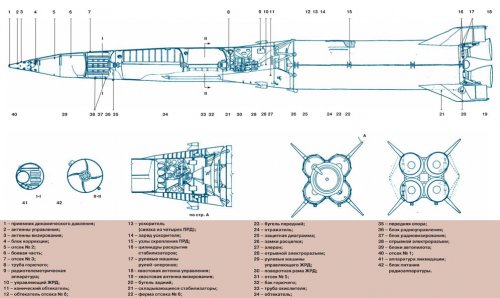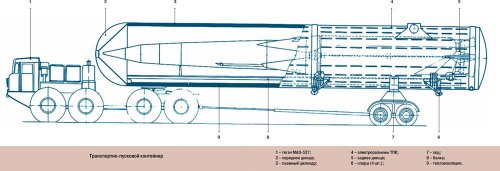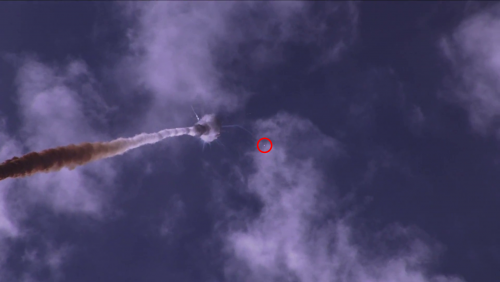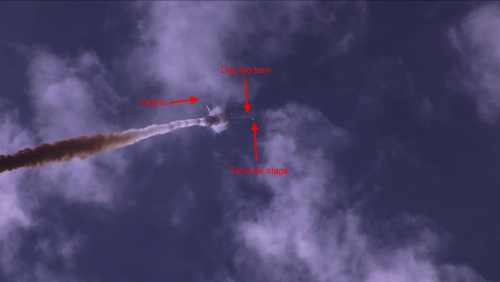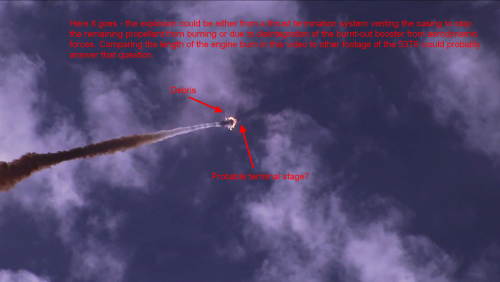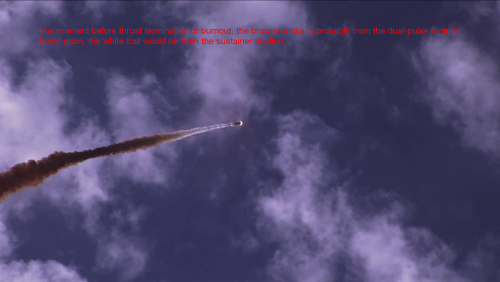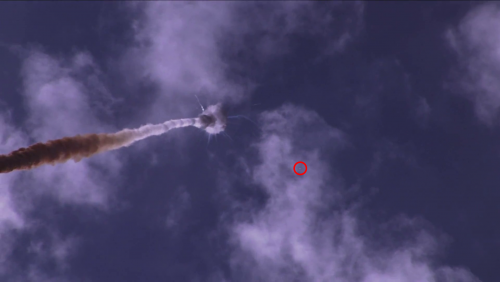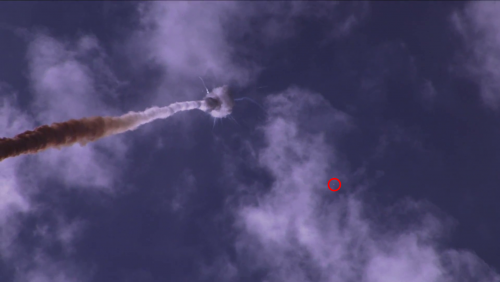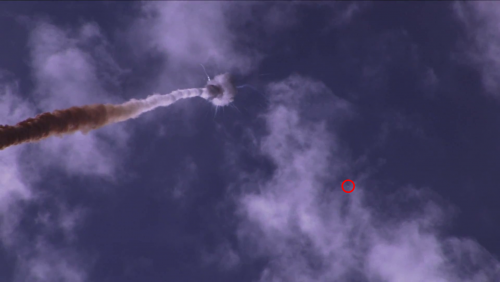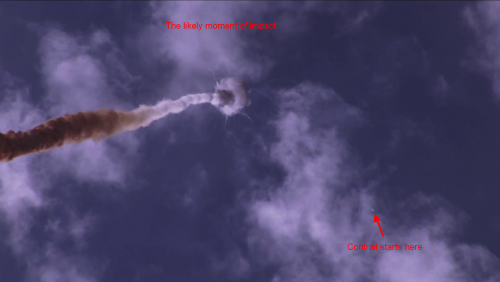You are using an out of date browser. It may not display this or other websites correctly.
You should upgrade or use an alternative browser.
You should upgrade or use an alternative browser.
Soviet ABM systems
- Thread starter overscan (PaulMM)
- Start date
Well, it's not a copy-paste; it's just a straight OCR of the revelant interesting bits of that DARPA document relating to ABM to make the information more accessible for people -- for one, you can't easily CTRL-F a PDF, unless it's a really really good scan enabling good inbuilt OCR by Acrobat.
- Joined
- 21 April 2009
- Messages
- 13,755
- Reaction score
- 7,691
Trident said:Having read Ryan's write up on HIBEX:
http://www.alternatewars.com/WW3/WW3_Documents/DARPA/DARPA_II_HIBEX.htm
... and some related documents I had downloaded from dtic a while a go, it occurred to me that 53T6 in many ways has more conceptual similarity to a longer range, more conventional HIBEX/UPSTAGE combination than to Sprint.
Just wanted to put that thought out there.
What incredible technology now going back close to 50 years. 8000 feet per second in one second, wow
I think CKEM/LOSAT approaches this kind of level. The problem is very high thrust solid motors have limited applications, and that kind of speed does place a lot of stress onto whatever guidance system you have for controlling it.
- Joined
- 3 June 2011
- Messages
- 18,335
- Reaction score
- 12,233
RyanCrierie said:Well, it's not a copy-paste; it's just a straight OCR of the revelant interesting bits of that DARPA document relating to ABM to make the information more accessible for people -- for one, you can't easily CTRL-F a PDF, unless it's a really really good scan enabling good inbuilt OCR by Acrobat.
I copy/paste out of PDFs all the time. I've even copy/pasted that exact document for stuff on other sites.
- Joined
- 3 June 2011
- Messages
- 18,335
- Reaction score
- 12,233
bobbymike said:Trident said:Having read Ryan's write up on HIBEX:
http://www.alternatewars.com/WW3/WW3_Documents/DARPA/DARPA_II_HIBEX.htm
... and some related documents I had downloaded from dtic a while a go, it occurred to me that 53T6 in many ways has more conceptual similarity to a longer range, more conventional HIBEX/UPSTAGE combination than to Sprint.
Just wanted to put that thought out there.
What incredible technology now going back close to 50 years. 8000 feet per second in one second, wowIs there a reason we aren't using this type of missile speeds on anti-tank and other munitions technologies?
That's nothin'. I have a DARPA paper around here somewhere where they were looking at a missile for antitank purposes years ago that would have been substantially better in the acceleration dept than Hibex (although it's may have been for less time leading to a lower top speed). The part that really impressed me about the Hibex stuff is they actually tested external burning. And it worked.
- Joined
- 3 June 2011
- Messages
- 18,335
- Reaction score
- 12,233
RyanCrierie said:I think CKEM/LOSAT approaches this kind of level. The problem is very high thrust solid motors have limited applications, and that kind of speed does place a lot of stress onto whatever guidance system you have for controlling it.
I wonder what kind of G-levels Raytheon's Quick Kill sustains.
Tuomasn
ACCESS: Secret
- Joined
- 5 January 2006
- Messages
- 477
- Reaction score
- 358
Thank you rambo54 for your continued input and insight. Regarding "Site 1" I don't think its unlikely they could have tested 5Ya27 from "Galosh type" launchers. Also we obviously don't know what the launchers exactly looked like: were they identical to Galosh ones or just looked similar when viewed from a few hundred kilometers up. But I admit it could also be for some other program (but what?)
Edit: reading DIMMI's latest S-225 article update I think "Site 1" could be the Azov first ("maket"?) version test site.
I think the northern radar site is the original FLAT TWIN radar prototype with traditional reflector-type transmitter and phased array receiver that was disassembled in January 1987 and some components moved to an electronics plant in Gomel creating some controversy (see http://findarticles.com/p/articles/mi_m1079/is_n2132_v88/ai_6536481/pg_10/ and http://www.osaarchivum.org/files/holdings/300/8/3/text/143-4-207.shtml for example). The southern site could be the second prototype with phased array receiver and transmitter. Related reading: THE FLAT TWIN ABM RADAR: NOT AS CAPABLE AS PREVIOUSLY BELIEVED (SW 91-10069) http://www.foia.cia.gov/docs/DOC_0000498654/DOC_0000498654.pdf.
The layout of the launch and radar sites among other things make me think "Site 2" is the launch site for the full-up 5Ya27 tests and "Site 4" for the full-up 5Ya26 tests.
P.S. You said you have done some research concerning the SS-16. If you can put up a summary of your findings so far perhaps you could create a topic to the Missile Projects section?
Edit: reading DIMMI's latest S-225 article update I think "Site 1" could be the Azov first ("maket"?) version test site.
I think the northern radar site is the original FLAT TWIN radar prototype with traditional reflector-type transmitter and phased array receiver that was disassembled in January 1987 and some components moved to an electronics plant in Gomel creating some controversy (see http://findarticles.com/p/articles/mi_m1079/is_n2132_v88/ai_6536481/pg_10/ and http://www.osaarchivum.org/files/holdings/300/8/3/text/143-4-207.shtml for example). The southern site could be the second prototype with phased array receiver and transmitter. Related reading: THE FLAT TWIN ABM RADAR: NOT AS CAPABLE AS PREVIOUSLY BELIEVED (SW 91-10069) http://www.foia.cia.gov/docs/DOC_0000498654/DOC_0000498654.pdf.
The layout of the launch and radar sites among other things make me think "Site 2" is the launch site for the full-up 5Ya27 tests and "Site 4" for the full-up 5Ya26 tests.
P.S. You said you have done some research concerning the SS-16. If you can put up a summary of your findings so far perhaps you could create a topic to the Missile Projects section?
- Joined
- 21 April 2009
- Messages
- 13,755
- Reaction score
- 7,691
sferrin said:bobbymike said:Trident said:Having read Ryan's write up on HIBEX:
http://www.alternatewars.com/WW3/WW3_Documents/DARPA/DARPA_II_HIBEX.htm
... and some related documents I had downloaded from dtic a while a go, it occurred to me that 53T6 in many ways has more conceptual similarity to a longer range, more conventional HIBEX/UPSTAGE combination than to Sprint.
Just wanted to put that thought out there.
What incredible technology now going back close to 50 years. 8000 feet per second in one second, wowIs there a reason we aren't using this type of missile speeds on anti-tank and other munitions technologies?
That's nothin'. I have a DARPA paper around here somewhere where they were looking at a missile for antitank purposes years ago that would have been substantially better in the acceleration dept than Hibex (although it's may have been for less time leading to a lower top speed). The part that really impressed me about the Hibex stuff is they actually tested external burning. And it worked.
sferrin - if you find that paper maybe you can post it and start a new thread for discussion. Maybe revolving around high speed rockets and missiles or solid rocket energetics in general.
- Joined
- 3 June 2011
- Messages
- 18,335
- Reaction score
- 12,233
bobbymike said:sferrin - if you find that paper maybe you can post it and start a new thread for discussion. Maybe revolving around high speed rockets and missiles or solid rocket energetics in general.
I wouldn't be at all surprised if there were a thread like that around here. Seems like I did one like that at one time or another. May not have been this board though. I'll look into it.
The CIA Doc http://www.foia.cia.gov/docs/DOC_0000278540/DOC_0000278540.pdf includes the following drawing
 .
.
It is from 1982. The illustration of the long range launcher could give us an impression on how the launch technique of the "final" 5Ya27 could look like...e.g. for those mysterious "vertical launching tables" at their site 2, though?
BTW: The Pictures on Dimmi's website which show the 5K17 at Sary Shagan obviously show the final Radar and not the prototype. But the remains which we can see on Terraserver ( 46.439336° 72.847505°) which are left at exactly this site in 2005 look somewhat different. It reminds me to a Pawn Shop "without the roof" concept...the dimensions are 18m x 7m (approx.)...but I have no dimensions for Pawn Shop.

It is from 1982. The illustration of the long range launcher could give us an impression on how the launch technique of the "final" 5Ya27 could look like...e.g. for those mysterious "vertical launching tables" at their site 2, though?
BTW: The Pictures on Dimmi's website which show the 5K17 at Sary Shagan obviously show the final Radar and not the prototype. But the remains which we can see on Terraserver ( 46.439336° 72.847505°) which are left at exactly this site in 2005 look somewhat different. It reminds me to a Pawn Shop "without the roof" concept...the dimensions are 18m x 7m (approx.)...but I have no dimensions for Pawn Shop.
There is an interesting missile on Dimmi's Page
http://military.tomsk.ru/forum/viewtopic.php?f=401&t=509&start=40
It's from an video made 2007. The screenshot is from inside the technical complex at site 7 which prepare the tests. In the video they finally fire a 53T6 from site 35. But this specific missile is strange. It remembers the upper stage of 51T6 or 5Ya27 but this is impossible in 2007. 51T6 tests stopped in 2002. Any ideas what sort of missile they had there?
BTW: by comparing many pictures I would rule out 51T6
P.S.: see update of Dimmi's page http://military.tomsk.ru/blog/category/10/topic-354.html
http://military.tomsk.ru/forum/viewtopic.php?f=401&t=509&start=40
It's from an video made 2007. The screenshot is from inside the technical complex at site 7 which prepare the tests. In the video they finally fire a 53T6 from site 35. But this specific missile is strange. It remembers the upper stage of 51T6 or 5Ya27 but this is impossible in 2007. 51T6 tests stopped in 2002. Any ideas what sort of missile they had there?
BTW: by comparing many pictures I would rule out 51T6
P.S.: see update of Dimmi's page http://military.tomsk.ru/blog/category/10/topic-354.html
Tuomasn
ACCESS: Secret
- Joined
- 5 January 2006
- Messages
- 477
- Reaction score
- 358
rambo54 said:It is from 1982. The illustration of the long range launcher could give us an impression on how the launch technique of the "final" 5Ya27 could look like...e.g. for those mysterious "vertical launching tables" at their site 2, though?
I agree, it would fit the description of a "launching table mounted between upright supports". Still it looks somewhat strange to my eyes (too simplistic perhaps?)
BTW: The Pictures on Dimmi's website which show the 5K17 at Sary Shagan obviously show the final Radar and not the prototype. But the remains which we can see on Terraserver ( 46.439336° 72.847505°) which are left at exactly this site in 2005 look somewhat different. It reminds me to a Pawn Shop "without the roof" concept...the dimensions are 18m x 7m (approx.)...but I have no dimensions for Pawn Shop.
Do you mean the greenish thing on the southwest side of the overlaid area?
Also notice that there were (at least) three FLAT TWIN radars: the first RSN-225 prototype (at the northern site?) the second RSN-225 prototype (at the southern site?) and the 5K17 that was tested at Sary Shagan (but where?) and then moved to Kamchatka.
Tuomasn
ACCESS: Secret
- Joined
- 5 January 2006
- Messages
- 477
- Reaction score
- 358
Happy New Year!
I agree the black & white image in Dimmi's site shows this southern site. However, are we sure it shows the 5K17 that went to Kamchatka? I think it is the second RSN-225 prototype (maybe (deliberately?) mislabeled by the source), and the 5K17 was tested somewhere else (maybe at 46.441337° 72.857199°)? Also, I think the satellite image could still show just a FLAT TWIN, perhaps partially disassembled? The width of 18 meters would be about right.
Actually this is the B-200 radar of the S-25 (SA-1) system. Image from http://smi2.ru/Wellda/c376819.

Regarding the S-225 launchers, my hypothesis is the following:
-5Ya27 was tested in 1967-1971 from "Galosh-type" launchers at "Site 1", first unguided and then with "maket" S-225.
-5Ya27 was tested in 1973-1977 from launch containers on a launching table mounted between upright supports at "Site 2" with first prototype S-225.
-5Ya26 was tested in 1973-1976 from a rail launcher at an early test site, first unguided and then with first prototype S-225.
-5Ya26 was tested in 1977 - March 1979 from lauch containers at "Site 4" with first prototype S-225.
-5Ya26 was tested in July 1979 from a silo at "Site 4" with second prototype S-225, but the silo was destroyed.
-5Ya26 was tested in August 1979 - April 1984 from silos at "Site 3" with second prototype S-225.
I have updated the file at http://personal.inet.fi/cool/foxfour/temp/Site35.kmz
rambo54 said:The remaining Radar can be seen on Terraserver
At least for me it looks like a Radar sitting right on the same pad at which you can see "Dimmi's 5K17.
The picture is from 2005. On a picture made in 2008 it is removed.
<snip>
The 5K17 went to Kamchatka later on and was dismantled there at around 2006.
So this was the three fixed (or "principle movable") Radars. But if this "thing" which remained at the pad up to 2006/7 at site 35 was indeed a Radar, what sort of Radar would it be?
I did an overlay in my own kmz - it measures about 18m x 6.5m and for me (!) it looks like a "Pawn Shop without roof".
Well...sadly enough this site 35 can not be visited by tourist like on site 52 (http://www.olgino.info/index.php?ind=reviews&op=entry_view&iden=36) and so we have not enough pictures from this site...
I agree the black & white image in Dimmi's site shows this southern site. However, are we sure it shows the 5K17 that went to Kamchatka? I think it is the second RSN-225 prototype (maybe (deliberately?) mislabeled by the source), and the 5K17 was tested somewhere else (maybe at 46.441337° 72.857199°)? Also, I think the satellite image could still show just a FLAT TWIN, perhaps partially disassembled? The width of 18 meters would be about right.
S-225 Radar:
I found a very bad picture of the so called S-200 prototype Radar mentioned in Dimmi's article

Actually this is the B-200 radar of the S-25 (SA-1) system. Image from http://smi2.ru/Wellda/c376819.

Regarding the S-225 launchers, my hypothesis is the following:
-5Ya27 was tested in 1967-1971 from "Galosh-type" launchers at "Site 1", first unguided and then with "maket" S-225.
-5Ya27 was tested in 1973-1977 from launch containers on a launching table mounted between upright supports at "Site 2" with first prototype S-225.
-5Ya26 was tested in 1973-1976 from a rail launcher at an early test site, first unguided and then with first prototype S-225.
-5Ya26 was tested in 1977 - March 1979 from lauch containers at "Site 4" with first prototype S-225.
-5Ya26 was tested in July 1979 from a silo at "Site 4" with second prototype S-225, but the silo was destroyed.
-5Ya26 was tested in August 1979 - April 1984 from silos at "Site 3" with second prototype S-225.
I have updated the file at http://personal.inet.fi/cool/foxfour/temp/Site35.kmz
Thanks Meteorit!
I didn't know that they had two Prototypes. But this means that obviously one (the one in Dimmi's picture) look like the operational version (5K17 like) and remained there up to 2006, while the other prototype went to Gomel. And the "real" 5K17 (sitting elsewhere at the site) then went to Kamchatka.
Maybe I understand the article on Dimmi's site wrong when I thought that there was a B-200 modification present at site 35.
Your analysis seems logic to me as it is the case with your launcher assessment. Maybe the prototype silo wasn't destroyed but the 5Ya26 missile when fired from it and that leads to the analysis that they had the wrong silo design and they blow up the silo later on and created the new ones (18m - with more space under the missile canister as we can see it in some drawings) at CIA site 3.
BTW: I have my doubts about the thesis that 5Ya27 was also tested in a silo at a certain time at site 35. That missile is significant longer. And the deeper silos (22m) were realized at site 52 and in use for 51T6.
I didn't know that they had two Prototypes. But this means that obviously one (the one in Dimmi's picture) look like the operational version (5K17 like) and remained there up to 2006, while the other prototype went to Gomel. And the "real" 5K17 (sitting elsewhere at the site) then went to Kamchatka.
Maybe I understand the article on Dimmi's site wrong when I thought that there was a B-200 modification present at site 35.
Your analysis seems logic to me as it is the case with your launcher assessment. Maybe the prototype silo wasn't destroyed but the 5Ya26 missile when fired from it and that leads to the analysis that they had the wrong silo design and they blow up the silo later on and created the new ones (18m - with more space under the missile canister as we can see it in some drawings) at CIA site 3.
BTW: I have my doubts about the thesis that 5Ya27 was also tested in a silo at a certain time at site 35. That missile is significant longer. And the deeper silos (22m) were realized at site 52 and in use for 51T6.
Tuomasn
ACCESS: Secret
- Joined
- 5 January 2006
- Messages
- 477
- Reaction score
- 358
rambo54 said:Maybe I understand the article on Dimmi's site wrong when I thought that there was a B-200 modification present at site 35.
It should be a modified radar of the S-200 (SA-5) system, presumably the 5N62 SQUARE PAIR, not B-200 "Yo-Yo" radar of the S-25 (SA-1) system, from what I understand.

- Joined
- 27 December 2005
- Messages
- 17,748
- Reaction score
- 26,407
http://www.vko.ru/DesktopModules/Articles/ArticlesView.aspx?tabID=320&ItemID=406&mid=2891&wversion=Staging
Nice article on the A-350.
Nice article on the A-350.
Anti-missile missile, which has no analogues
Records for distance and altitude of interception of ballistic targets set by the product of A-350ZH, and today is admired
In the missile defense system in Moscow A-35 (35M) A unique amm-350ZH (5V61) design Peter D. Grushin was intended to deliver a warhead to the area meeting with the purpose and defeat it with a given probability.
Draft Project A-350ZH was completed in March 1961 issue of technical documentation on missile completed in 1963, onboard equipment and electrical missile engaged Yevgeny Afanasyev, ground equipment - Fyodor Kuleshov, and theoretical calculations led Boris navel. General management, together with Peter Grushin exercised his deputy Vladimir Kolyaskin. Until 1973 the lead designer of the A-350ZH was Vladimir Ermolenko. Since 1974, the lead designer on the upgraded A-350R was Igor Smetsky.
In 1958, the sustainer rocket engine design was given the chief designer of the Moscow OKB-1 MAP LS Dushkin, the development of solid propellant rocket launch - Chief Designer of KB-2 plant № 81 I. Kartukovu. In autumn 1960 PD Grushin send a technical mission to develop the sustainer rocket engine 5D16 chief designer of OKB-446A Leningrad. S. Meviusu, the development of solid propellant rocket launch 5S47 - chief designer of the Kazan OKB Soyuz PF teeth.
In the final version of the anti-missile missile was equipped with a marching LRE 5D22 created in Leningrad OKB-117 under the supervision of SP Izotov and PD Le Havre, and the start SPRM PF Jag. Production of main engines were deployed at the Leningrad plant "Red October", the production of starter motors - at the Kazan factory "Union" and Dolgoprudniy Mashzavod, later - at the Perm factory Mashinostroitel. Onboard equipment developed by OKB-30 KB-1 under the leadership of VI Nizimova, autopilot - OKB-36 KB-1 under the leadership of P. Kirillov. Starter and TPK were created under the leadership of the Leningrad OKB-232 TD Vylkosta.
A standard missile-350ZH released Dolgoprudniy Machine-Building Plant and the Moscow Machine Building Plant "Avangard". About 10 serial products have been collected into Zhulyanskom Mechanical Plant (branch of the Kiev Engineering Plant named after Artem) in Ukraine.
Throwing the first launches of products of modern 5TYA starting position Balkhash landfill began in April 1962 to May 1963 was carried out six launches. From September 1963 to October 1964 there were five launches of products received index 6TYA. 24 December 1965 was carried out missile launch A-350ZH of the box. In September 1967 began testing the A-350ZH from the launch pad firing of "Aldan".
DESIGN-A missiles 350ZH
Amm A 350ZH was a two-stage guided missile, made by a normal aerodynamic configuration with an X-shaped arrangement of wings and rudders, ailerons, with controls on the first and second stages.
The rocket consisted of the following main elements:
- Warhead;
- On-board equipment guidance;
- Autopilot with a set of servo;
- Engines of the first and second stages.
Missile warhead were filled by special charge, which ensure steady erosion of defeat warhead ballistic missile potential enemy in a radius of not less than 200 meters.
Onboard equipment sight was intended for the reception of radar pulses uplink channel products and issuing the response pulses containing information about the coordinates of the missile.
The composition of missile
On-board radio controls designed to receive commands missile flight control and issuing them on autopilot, as well as to receive occasional commands that control the main engine thrust and undermining of the warhead.
The autopilot was designed to control the steering gear missile, rotary engines and aircraft control surfaces and to stabilize the missile with respect to three mutually perpendicular axes.
In the first stage missile used a bunch of four propellant engines, which worked on the injection gunpowder PAL-18 / 7 with an electrical pulse at the surface 240 kg / kg / sec.
Engine second stage was a single-chamber rotary rocket engine with variable thrust. Engine runs on high-energy two-component fuel (AC-27P and dimethylhydrazine, in other words - heptyl) with a specific impulse in the upper atmosphere, 335 kg / kg / sec.
In accordance with general principles of construction of the A-35 and the requirements for it, amm A 350ZH had the following characteristics:
- Flight time - 80, 160 and 180 sec.;
- Range - 130, 350 and 400 km;
- Range of heights of destruction - from 50 to 400 km;
- Payload - 900 kg
including:
warhead - 700 kg
airborne radio - 150 kg
autopilot with a set of servo - 150 kg.
The propulsion system: the first step - a powder rocket engine, the second step - liquid rocket engine. Missile launch weight of A-350ZH - 29 750 kg.
A missile launch 350ZH performed with a constant angle to the horizon, equal to 78 degrees.
Modified thrust propulsion systems for missile flight time
Transport and storage of missile on the launcher implemented in transport-launch container.
Orientation of the missile in the plane of the output was made before the start of rotation of the launcher with the container at a given angle in the azimuth plane from the data obtained from GKVTS. Construction start the installation to allow U-turns in the corners of the place and azimuth errors of not more than 15 minutes of arc.
After starting at the output of the missile container occurred disclosure stabilizers first stage and started to work program mechanism inducing missile in the plane of the output. Opening time stabilizers did not exceed 0.5 seconds. The duration of the software mechanism was 8 seconds. During this time, the decline occurred missile at 8 degrees from the direction of the launch.
Changing the speed of a missile in time
The full range of missile flight was divided into three phases: acceleration, a march and guidance (forced operation of the engine).
Dispersal missiles occurred during the first and second stages, and lasted up to 45-50 seconds.
Control and stabilization during the first stage carried out four air rudders, ailerons, located on the folding stabilizers. Each wheel-aileron controlled by one hydraulic machine, located on the stabilizer. Maximum deflection angle of rudders, ailerons - plus or minus 25 degrees.
Control and stabilization of the second stage in two mutually perpendicular planes were made with an axial rotary rocket engine, was rejected by two hydraulic steering gear. Maximum deflection angle engine is plus or minus 10 degrees. Stabilization of the roll on the second stage was carried out using two aircraft ailerons and rigidly attached to the ailerons gas nozzles (auxiliary rotary engines), are on the same axis of rotation with air ailerons, since the deflection angles to be equal and of plus or minus 40 degrees.
Modified thrust propulsion systems for missile flight time
At the stage of acceleration is a division of the first and second stages of the missile.
The average flight time of the first stage was 28 seconds.
Resetting the first stage occurs when the thrust liquid propellant second stage 0.7 of its nominal value, but not before the thrust of the first stage to fall to zero.
Hours LRE in forced mode (after resetting the first stage) was determined based on the flight range of 350 km. After the end of the LRE forced a regime of propulsion thrust from the march.
Go to the marching part of the flight the second stage (throttling thrust) and the translation engine in the afterburner mode was performed on a one-time radio commands from the ground to reduce the influence of scatter missile flight data.
Both of these areas are in direct proportion to the estimated flight time, and missile interceptors were determined meeting point for the purpose.
The beginning of the cruise flight phase second stage ranged from 45 to 106 seconds, with a nominal value of 54.8 seconds.
Go to the forced operation on a finite segment of the flight is done with so that at the stage of aiming missiles at target in the last 30 seconds of flight enable the realization of maximum congestion.
The beginning of the afterburner engine second stage ranged from 45 to 155 seconds with a nominal value of 103.7 seconds. In the accompanying drawings shows the values of adjustable thrust of the first and second stages of the entire range missile flight, depending on flight time.
Magnitude overloads that are valid in different parts of the flight A missile 350ZH are shown in the table.
Bandwidth overload
In the accompanying figures show the performance characteristics for typical missile trajectories depending on time of flight. It also shows the shape of trajectories.
On the missile A-350ZH envisaged devices to ensure safety of exploitation, abandonment and emergency disruption.
Technical positions ATU-35
The technical position of the ATP-35 was designed to perform the following tasks:
- Reception of incoming missiles A-350 and the technological means of verification, storage and preparation for combat use;
- Long-term storage of missiles A-350 and holding them necessary maintenance works;
- Replenishment starting positions amm A-350 in peacetime and wartime;
- Receiving A-350 missiles and production equipment are returned to the starting position and carrying with them the necessary repairs.
The technical position was a complex of buildings, which consisted of:
- Discharge housing;
- Housing reactivation;
- Integration and test building;
- Warehouses empty and inert missiles;
- Filling stations nitrogen pressure;
- Refueling station;
- Oxidizer filling station;
- Housing equipment warhead;
- Warehouses completely filled missiles;
- Housing AKIPS.
Revolutionary feature for those times of the complex ground equipment, designed for use interceptors A 350ZH, is a transport-launching container (TLC), which made all the process of verification for missiles and technical positions, storing missiles and firing on the technical positions, transportation, and start interceptors.
TPC was sealed. Inside it, maintain the necessary temperature, pressure and humidity, allowing for a long time to keep missiles in the open air. On the launcher of the WPK with interceptors could be kept in the horizontal and the starting position.
Home missile was produced from closed-TPK, for what it is at the front was closed by a special rubber cap, and rear - rubber bottom. At the start of missile front hood and broke the bottom of the WPK, respectively, while the toe of the gas jet and missile launch motor.
Thus, TPK served assembly-connection equipment, transport vehicles, storage facilities and is part of the launcher. The general form of transport and launch container is shown in the accompanying figure.
With manufacturing plants amm A-350 arrived on technical position in the form of individual parts and assemblies.
On the technical position made the following main activities:
- External parts of the missile re-activation;
- Docked all parts of the missile with one another;
- Connect elektrogidropitaniya and conducting missile tests combined with AKIPS;
- Refueling sharballonov missiles nitrogen pressure;
- Refill of fuel and oxidizer;
- Equipment fragmentation warhead.
The sequence of activities carried out with missiles, is shown in the accompanying figure.
Scheme of the technological maintenance of the product A-350 for technical positions
After all of the works of the WPK with missiles supplied to the starting position or in a combat-ready missiles warehouse for storage or in reserve.
The whole technological cycle of 10 interceptor missiles A-350, from handling the case and ending with leaving the start position was 21 hours.
In the process of preparing the filling warehouses missile was the same as for the fill starting positions, with the exception of work on fuel missile with nitrogen, propellants and Equipment warhead.
The whole technological cycle of 10 interceptor missiles A-350, from handling the case and to installation of the WPK and warehouses, was 18 hours. At 11 stores hosted 220 of the WPK with missiles.
Interceptors that are in storage are periodically operational checks.
Routine checks collected, but empty and inert missiles were in the assembly and testing facility stationary parity-check means (ACIS).
Routine checks collected, filled and filled with missiles that are stored in warehouses, were carried out in the housing AKIPS sliding parity-check facilities.
Transport-launch canister
Routine tests are carried out without opening the TPC in 35 minutes, with the opening of the WPK - one hour 55 minutes.
In battle mode, giving missiles at launch sites from warehouses empty and inert missiles carried six missiles at a rate per hour.
Transportation of missiles in TPC was carried out using tractor MAZ-537 with a special trailer.
Amm A-350 is a unique product and without any exaggeration, a sort of masterpiece of the domestic defense industry. Records for distance and altitude of interception of ballistic targets set by this missile, and today is awe and admiration and pride for developers and manufacturers of truly unique technology.
Michael HODARENOK
Attachments
Actually, having looked at the video again in HD I'm pretty confident DIMMI's information about 53T6 having a single-stage, dual-pulse booster and an unpowered terminal dart is correct. What I first assumed to be a piece of debris from the disintegrating booster in fact seems to be the actual kill vehicle and the large explosion is thus not the warhead. It is seen to continue along the initial trajectory momentarily before executing a sharp turn to the right and heading for the point where the white left-right contrail later appears, although it is lost from sight before reaching that point. I've attached a few frame grabs to illustrate, although once you know what to look for it is actually more obvious when seen in motion (so I urge anybody who doubts it to re-watch the video after looking at my screen grabs).
Attachments
- Joined
- 3 June 2011
- Messages
- 18,335
- Reaction score
- 12,233
This seems to be a two-stage missile to me with a brief moment of coasting in between. You see a smoke trail start back up there to the right. (And is that thing going damn fast after the staging event or what?  ) I would guess the "explosion" we're seeing is the 1st stage coming apart at staging (there's a good video of Sprint staging and the first stage pretty much disintegrates.) The energy getting dumped into the atmosphere by this could be what's causing the shock wave that is briefly visible.
) I would guess the "explosion" we're seeing is the 1st stage coming apart at staging (there's a good video of Sprint staging and the first stage pretty much disintegrates.) The energy getting dumped into the atmosphere by this could be what's causing the shock wave that is briefly visible.
SOC?
SOC?
- Joined
- 1 April 2006
- Messages
- 11,390
- Reaction score
- 10,274
It's known for ages I thought (and in-house cutaway confirms it)Trident said:Actually, having looked at the video again in HD I'm pretty confident DIMMI's information about 53T6 having a single-stage, dual-pulse booster and an unpowered terminal dart is correct.
Well, while I never seriously doubted what he said, it was still pretty cool to actually see it in action and I thought DIMMI's cut-away was unofficial?
Another point, reading paralay's forum, people appear to be discussing whether or not there was an actual target RV. IMHO the contrail is consistent with a physical target being hit and the target trajectory shown on the colour map display would be about right for a launch from Kapustin Yar if you trace it back in GoogleEarth.
Another point, reading paralay's forum, people appear to be discussing whether or not there was an actual target RV. IMHO the contrail is consistent with a physical target being hit and the target trajectory shown on the colour map display would be about right for a launch from Kapustin Yar if you trace it back in GoogleEarth.
- Joined
- 1 April 2006
- Messages
- 11,390
- Reaction score
- 10,274
unofficial, but...correct at this part at least (unpowered terminal dart)Trident said:I thought DIMMI's cut-away was unofficial?
there was no actual target at this launch (as wize men say). and why pseudo-target can't give you pseudo-trajectory on a screen?)Trident said:IMHO the contrail is consistent with a physical target being hit and the target trajectory
Yeah, I did figure that he was probably not making that stuff up and had some kind of source for the configurationflateric said:unofficial, but...correct at this part at least (unpowered terminal dart)
True, but why would you not simulate an ICBM rather than a 2100km shot, if you were not constrained by available target missiles? You're better fit to judge whether the wize men speak the truthflateric said:there was no actual target at this launch (as wize men say). and why pseudo-target can't give you pseudo-trajectory on a screen?)
- Joined
- 3 June 2011
- Messages
- 18,335
- Reaction score
- 12,233
flateric said:It's known for ages I thought (and in-house cutaway confirms it)Trident said:Actually, having looked at the video again in HD I'm pretty confident DIMMI's information about 53T6 having a single-stage, dual-pulse booster and an unpowered terminal dart is correct.
What is the smoke that starts up there at the end if not a motor?
flanker
ACCESS: Top Secret
- Joined
- 20 March 2008
- Messages
- 933
- Reaction score
- 256
Sorry for possibly stupid question, as i am not too into ABM systems: If there was a target, what would the target typically be? I mean, it cant be Tu-143 or alike, can it? Gazelle is meant to destroy incoming re-entry vehicles. So, are they actually testing it on re-entry vehicles?
Some kind of atmospheric effect caused by the passage of an object moving at Mach 10 and its associated shock system? Exhaust from the divert thrusters? Ablative thermal protection system?sferrin said:What is the smoke that starts up there at the end if not a motor?
Yes, real RVs or simulated targets artificially introduced into the interceptor's guidance system (with success/failure evaluated based on telemetry).flanker said:So, are they actually testing it on re-entry vehicles?
- Joined
- 1 April 2006
- Messages
- 11,390
- Reaction score
- 10,274
uses gas-dynamic control systemsferrin said:What is the smoke that starts up there at the end if not a motor?
- Joined
- 3 June 2011
- Messages
- 18,335
- Reaction score
- 12,233
Trident said:Some kind of atmospheric effect caused by the passage of an object moving at Mach 10 and its associated shock system? Exhaust from the divert thrusters? Ablative thermal protection system?
Flaterics explanation (gas generator for kill vehicle manuevering system) makes sense, though that seems like a lot of exhaust for a divert system. An object moving through the air isn't going to cause a contrail unless it's outgasing something, be it ablation byproducts or exhaust. The only thing I didn't like about the video is it's so damn difficult to get a good perspective of altitudes, ranges, etc. (That goes for all SAM tests, not just this one.)[/quote]
flanker
ACCESS: Top Secret
- Joined
- 20 March 2008
- Messages
- 933
- Reaction score
- 256
Trident said:Yes, real RVs or simulated targets artificially introduced into the interceptor's guidance system (with success/failure evaluated based on telemetry).
Aha, makes sense. Thank you.
- Joined
- 3 June 2011
- Messages
- 18,335
- Reaction score
- 12,233
One thing that amazed me about this video is looking at some of the support equipment it really drives home that this system has been around a while. There was one bit where there was a computer that actually spit out paper tape. Not knocking it or anything, it's just one gets so used to seeing modern computers around I'm continually amazed at what was accomplished with far less in that regard.
Link to russian site
Google Translate of the above link:
Google Translate of the above link:
Umbrella of the suburbs
Russia has tested a modernized missile defense system
The Russian military conducted on the Kazakh test site Sary-Shagan test an advanced missile short-range missile defense system. Launch was a success; missile hit the conditional target on time. As announced Russian Ministry of Defense, the tests took place antimissile 53T6, which, according to an index, is in service since 1995. However, we can talk about a new tool to intercept, created under the modernization program of Moscow ABM system.
Launching missiles 53T6 place at 12:01 Moscow time on the Sary-Shagan test range in Kazakhstan. The purpose of the test was the confirmation of the tactical and technical characteristics of anti-missile missile defense system. Means to intercept the index 53T6 currently consists of a missile defense system in the A-135, entered service in 1995 and deployed around Moscow. Deputy Commander of the Aerospace Defense Sergei Lobov said that running anti-missile missile struck a conditional goal on time.
Soon after reports of trials held at the site of the Ministry of Defence of Russia appeared short video about the launch of 53T6. In it, in particular, argues that the trial of anti-missile missile is a "fundamentally new development of domestic arms industry" capable of developing "top speed", and almost all the elements of rockets "are used for the first time." Presumably, we are talking about some of the structural elements of missile, new engines and upgrade software.
Surprisingly, although the new missile is "a fundamentally new development", the index remained unchanged, as is commonly done in the case of upgrading existing or developing new weapons. In any case, many important details about the new missiles have not been announced, including belonging to a missile defense system and specifications. The predecessor of the new 53T6 - 53T6 old - with a length of ten meters, the diameter of one meter and weight of about ten tons is capable of hitting ballistic objects at a distance of 80 kilometers and at altitudes up to 30,000 meters.
Tests of missiles at Sary-Shagan test range from the adoption of A-135 into service are held regularly. Over the past four years, the current test run was the third and sixth time ever alerting the A-135 (video on trial in 2009 can be found here ). The penultimate time amm 53T6 in Kazakhstan was launched in October 2010. Presumably, the purpose is to check the latest launches of various components of the improved part of a larger program to modernize the missile defense system to the A-235.
Development of a missile defense system A-135 began in 1971. The new missile, which was to replace the obsolete A-35M, was supposed to include two types of missiles - 51T6 intended for trans-atmospheric intercept targets at altitudes of up to one hundred thousand feet and range up to 600 kilometers, and 53T6. The Council of Ministers of the USSR to begin construction of the A-135 was signed in 1978, it also contained an order to start developing a modernized missile defense system.
It should be noted that the creation and construction of the A-135 was carried out already in the Soviet-American indefinite "ABM Treaty" signed in 1972. According to the document, each party has the right to build no more than two anti-missile systems equipped with each no more than a hundred fixed launchers. In 1974 terms and conditions have tightened - the parties are now allowed to have no more than one system. United States under a contract put your system at a military base Grand Forks, but a year later dismantled it. The Soviet Union decided to cover the Moscow ABM system. "ABM Treaty" is not valid from June 2002, when the U.S. withdrew from the agreement and began to develop its own missile defense system in Europe.
Construction of the A-135 for the most part ended in the mid-1980s. During the creation of a series of successful tests, which confirmed the ability to intercept ballistic missiles purposes, including such complex, as cloven warheads of individual guidance. On duty firing complexes A-135, has a total of one hundred missiles, rose in 1995, after lengthy testing and refinement.
In addition to missiles (51T6, according to unconfirmed reports, were fitted with nuclear warheads to increase the chances of destroying ballistic targets) in the A-135 came in and radar "Don-2NP," placed far from the Moscow region Sofrino. Radar is a truncated pyramid, the length and width are equal to one hundred meters, and height - 35 meters. This station is capable of controlling the space at a distance of two thousand kilometers (other sources - 3,7 thousand kilometers) and at an altitude of 40 thousand kilometers. The radar provides the supercomputer "Elbrus-2."
Officially 51T6 missiles were removed from the set of A-135 in 2002-2003 due to end of life. However, according to unconfirmed reports, they are still in the mines and are on alert. In addition, it is considered that the modernized or 51T6 missiles, based on them, will become part of the modernized A-235. Contract for the last signed in 1991. Completion of works is scheduled for 2015.
A development of 235 deals with the Russian company "Almaz-Antei", leading the work on several projects: RTC-181M (the same A-235) and "Airplane-M" (the creation of new warheads for missiles). Reliable information on the upgraded missile defense system there. We only know that in 2009, Concern "Radio and Information Systems" has completed the modernization of the radar receiver sections, "Don-2NP" and produced the upgraded kits transmitting station sections.
Presumably, the computing power of the A-135 in the updated A-235 will be replaced, instead of the outdated "Elbrus-2" will set a new supercomputer "Elbrus-3M". In addition, A-235 will consist of three levels. The composition of long-range missiles will train on the basis of 51T6, capable of hitting targets at ranges up to 1.5 kilometers and at altitudes of up to 800 thousand meters. For the middle tier will be created 58R6 firing complex, designed to engage targets at ranges of up to thousands of kilometers and at altitudes of up to 120 thousand meters.
Finally, in passing train can be included missile 53T6M (probably one of them has been tested and December 20, 2011) or 45T6 (53T6 are based on). They can destroy targets at a distance of 350 kilometers and in height, according to various estimates, 40-50 thousand feet. Presumably, the long-range missile train will be equipped with nuclear warheads.
Until now, work to create a modernized version of the A-135 were conducted in an atmosphere of silence - in the press leaked limited information on missile launches, the creation of advanced structural elements or the prospects of developing new types of missiles.
It seems that the current hype around the trials held in Kazakhstan missile (deliberate eulogy of the principal military and novelty "record speed" and even the publication of video on the site run the Defense Ministry, which has never been done before) has become part of the current government policy response to the deployment of U.S. missile defense system in Europe. In the same way as they were, and deploying a new radar nadgorizontnoy in Kaliningrad, and many other steps that are actually quite effective, but excessively and awkwardly make an issue of political rhetoric in favor of the Russian government.
Since 2008, Russia and the CIS creates a unified system of air and missile defense, designed to combine the management and exchange of information between different systems. In fact, within the framework of the combined system will be erased the line between tactical and strategic missile defense system in Russia. At the same time in Russia in December, nearly completed the formation of air and space defense - from December 1, 2011 to alert the troops barred ASD.
The concept of the new unified system involves the creation of multilayered missile defense system. It will include short-range "Tunguska", "Tor-M2" and "Armour-C1" and medium-and long-range S-300, S-400 and from 2015 - C-500. Currently, all of these complexes form and object troop defense, but not formally belong to the tactical missile defense Russia. The upper "layer" of a single Russian missile defense, obviously, will be A-235.
In January 2011, Russian General Staff chief Gen. Nikolai Makarov, said that the combined system will enable the country to get "umbrella," which closes it, "against ballistic missiles of intermediate range missiles, cruise missiles from various bases - air, sea, land - in including extremely low altitudes at any time, in any situation. "
- Joined
- 26 September 2008
- Messages
- 1,960
- Reaction score
- 746
sferrin said:One thing that amazed me about this video is looking at some of the support equipment it really drives home that this system has been around a while. There was one bit where there was a computer that actually spit out paper tape. Not knocking it or anything, it's just one gets so used to seeing modern computers around I'm continually amazed at what was accomplished with far less in that regard.
Well, the Russian military doesn't have the best equipment. (Alas, I've also heard of a key USAF system that uses a mid-1980s mainframe.)
But there might also be reasons other than lack of money to stick with older and cruder electronics--this system was supposed to operate in a nuclear environment, and you might be better off with vacuum tubes than modern integrated circuits.
Here's a very nice report on the Don-2N battle management radar with excellent interior shots:
missiles.ru :: РЛС ПРО Дон-2Н
missiles.ru - russian missile technology, 1-st RUSSIAN MISSILE SITE, 1-й Российский сайт о ракетной технике и технологии, РЛС Дон-2Н, ПРО, А-135, 51Т6, противоракета
missiles.ru


